Date founded c. 1820 | Art Description | |
 | ||
Founder Chiba Shūsaku Taira no Narimasa(千葉 周作 平 成政) Current headmaster Various lineages are still extant and taught | ||
Hokushin Ittō-ryū Hyōhō (北辰一刀流兵法) is a koryū (古流) which was founded in the late Edo period (1820’s) by Chiba Shusaku Narimasa (千葉周作成政, 1794- 1856). He was one of the last masters who was called a Kensei (sword saint).
Contents
Curriculum and Characteristics
The curriculum of the ryūha contains mainly Kenjutsu, Battōjutsu, Naginatajutsu and Jūjutsu. But the main weapons used are the long sword and short sword (Katana and Wakizashi).
The Hokushin Ittō-ryū is a very intense dueling style, which focuses on simple and fast techniques where no unnecessary movements are made. Controlling the enemy’s center line with the Kiri-Otoshi and dominating him with extremely fast tsuki-waza are the signature techniques of this ryūha. The principles of this style are that a perfect technique should contain defence and offense in one action.
Characteristic for the training is the use of Onigote (heavily padded gloves) like in its ancestor styles Ono-ha Ittō-ryū and Nakanishi-ha Ittō-ryū which are used in several Kumitachi-Kata (two person practice). This kind of training became more and more obsolete at the end of the Edo-period with the spread of Gekiken and the use of Bogu and Shinai.
This style is also one of the few remaining ryūha which is still training Kumitachi with Shinken (real swords). One has in order to become Shihan, master every technique with Shinken (Kumitachi and Battōjutsu). This is a very dangerous training method but guarantees, that the quality of those masters is held on a very high level.
Famous Swordsmen
At the end of the Bakumatsu period (1853-1867), the Hokushin Ittō-ryū was one of the three biggest and most famous ryūha all over Japan. Swordsmen of the Hokushin Ittō-ryū had a strong influence on the development of modern Kendō in the late 19th century. Also many famous and politically influential people were masters of this swordsmanship school.
Some of the most prominent names:
Ranking System
The Hokushin Ittō-ryū has three teaching steps:
Like many other koryū, the Hokushin Ittō-ryū traditionally awards makimono-scrolls and/ or inka-jō. There is no modern Dan system in the school. The traditional five scrolls of Hokushin Ittō-ryū are:
- Kirigami 剪紙
- Hatsumokuroku 初目録
- Kajōmokuroku / Seigandenju 箇条目録 / 星眼伝授
- Chūmokuroku / Menkyo 中目録 / 免許 (full transmission of all techniques)
- Daimokuroku / Menkyo-Kaiden 大目録 / 免許皆伝 (full transmission of the ryūha)
The so-called Naginata Mokuroku 長刀目録 also exists and is normally issued together with the Menkyo (Chūmokuroku). It certifies the mastery of all Naginatajutsu techniques of the school.
Old Main lines
The two main lines were that of the Kaiso Chiba Shusaku Narimasa and his Edo-Genbukan, the other was that of his brother Chiba Sadakichi Masamichi with the Chiba-Dôjô. In the end of the Meiji period, the line of the Edo-Genbukan became extinct. The Chiba-Dojo line, unlike that of the Edo-Genbukan survived until today. Currently the Hokushin Ittō-Ryū Hyōhō is headed by Ōtsuka Ryūnosuke Masatomo as the 7thSoke.
Edo-Genbukan (extinct)
Chiba Shûnosuke Koretane restored the Edo-Genbukan in 1883 with the help of Inoue Hachirō and Yamaoka Tesshū. The Edo-Genbukan was closed around the 20th – 30th year of the Meiji-period. The exact date is unknown.
Chiba-Dojo
The Chiba-Dōjō of Chiba Sadakichi Masamichi (younger brother of schools founder) became one of the most famous Dōjō all over Japan after its foundation in the late 1840s. The teaching-line of the Edo-Genbukan disappeared soon after the Dōjō was closed at the end of the Meiji period. The Chiba-Dōjō was also closed at the beginning of the Taisho period, but this line, unlike that of the Edo-Genbukan, survived until today. However, as the 5th Generation Sōke, Chiba Hiroshi did not learn and actively practice his family art, he appointed the Menkyo-Kaiden Ōtsuka Yōichirō Masanori as the 6th Sōke of this line. He was then succeeded by his adopted adult foster son Ōtsuka Ryūnosuke (formerly known as Markus Lösch) in March 2016 who then became the 7th Sōke.
Side lines
At the middle of the Meiji-period there were many side branches, founded by pupils of the two main lines. One of the most famous was the Tobukan in Mito. It was established by Ozawa Torakichi, a student of the Edo-Genbukan. Ozawa Torakichi was also an instructor at the Kodokan, the official clan school of the Mito-clan. After the Meiji-restoration and the abolishment of the traditional clan system the Kodokan was closed, so in order to continue teaching, Ozawa Torakichi opened his own Dôjô, the Tobukan. There he taught Hokushin Itto-ryu together with Shin Tamia-ryu. Up until today, the Ozawa family is still preserving the teachings of its first headmaster at the Tobukan in Mito.
Mito-Tobukan (Ozawa-ha)
Otaru-Genbukan (Noda-ha)
(This Dojo is not to be mistaken with the Edo-Genbukan)
